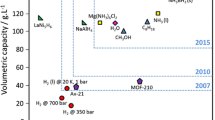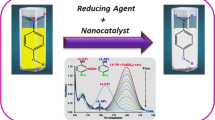Abstract
Five nanometal catalysts of Fe, Co, Ni, Cu and Zn were prepared by single displacement reaction and evaluated their catalytic activity towards thermal decomposition of ammonium perchlorate (AP) with respect to lowering of decomposition temperature, boosting of heat energy release and larger evolution of oxidizing decomposition products. The peak temperature of high temperature decomposition was decreased by 93, 55, 47, 15 and 13 °C by adding 0.5% each of Zn, Cu, Ni, Co and Fe respectively. The highest heat energy of 1910 J g−1 was obtained for 0.5% Cu. The evolved gases analysis using thermogravimetry-mass spectrometry revealed new inputs to the catalysed decomposition of AP, especially with respect to chlorine gas evolution. Among the five catalysts studied, copper nanometal powder emerged as the most promising catalyst for thermal decomposition of AP, which can improve the burn rate of the propellant enormously with reduced mass penalties.
Graphical abstract











Similar content being viewed by others
Code availability
Not applicable.
References
Jacob PWM, Whitehead HM. Decomposition and combustion of ammonium perchlorate. Chem Rev. 1969;69:551–90.
Wang Y, Zhu J, Yang X, Lu L, Wang X. Preparation of NiO nanoparticles and their catalytic activity in the thermal decomposition of ammonium perchlorate. Thermochim Acta. 2005;437:106–9.
Yan Q, Zhao F, Kuo KK, Zhang X, Zeman S, DeLuca LT. Catalytic effects of nano additives on decomposition and combustion of RDX-, HMX-, and AP-based energetic compositions. Prog Energy Combust Sci. 2016;57:75–62.
Bekhouche S, Trache D, Abdelaziz A, Tarchoun AF, Boukeciat H. Effect of fluorine-containing thermite coated with potassium perchlorate on the thermal decomposition behavior and kinetics of ammonium perchlorate. Thermochim Acta. 2022. https://doi.org/10.1016/j.tca.2022.179413.
Zhang J, Jin B, Hao W, Song Y, Hou C, Huang T, Peng R. Catalytic thermal decomposition of ammonium perchlorate by a series of lanthanide EMOFs. J Rare Earths. 2023;41:516–7.
Dave PN, Sirach R. NiZnFe2O4: a potential catalyst for the thermal decomposition of AP and burn rate modifier for AP/HTPB based propellants. J Therm Anal Calorim. 2022;147:10999–1012.
Chalghoum F, Trache D, Benziane M, Benhammada A. Effect of micro- and nano-CuO on the thermal decomposition kinetics of high-performance aluminized composite solid propellants containing complex metal hydrides. FirePhysChem. 2022;2:36–14.
Cui P, Wang A. Synthesis of CNTs/CuO and its catalytic performance on the thermal decomposition of ammonium perchlorate. J Saudi Chem Soc. 2016;20:343–8.
Benhammada A, Trache D, Chelouche S, Mezroua A. catalytic effect of green CuO nanoparticles on the thermal decomposition kinetics of ammonium perchlorate. Z fur Anorg Allg Chem. 2021;647:312–4.
Yang J, Zhang W, Liu Q, Sun W. Porous ZnO and ZnO–NiO composite nano/microspheres: synthesis, catalytic and biosensor properties. RSC Adv. 2014;4:51098–104.
Paulose S, Raghavan R, George BK. Graphite oxide–iron oxide nanocomposites as a new class of catalyst for the thermal decomposition of ammonium perchlorate. RSC Adv. 2016;6:45977–85.
Chen L, Zhu D. The particle dimension controlling synthesis of α-MnO2 nanowires with enhanced catalytic activity on the thermal decomposition of ammonium perchlorate. Solid State Sci. 2014;27:69–72.
Chaturvedi S, Dave PN. A review on the use of nanometals as catalysts for the thermal decomposition of ammonium perchlorate. J Saudi Chem Soc. 2013;17:135–49.
Duan H, Lin X, Liu G, Xu L, Li F. Synthesis of Ni nanoparticles and their catalytic effect on the decomposition of ammonium perchlorate. J Mater Process Technol. 2008;208:494–8.
Liu L, Li F, Tan L, Ming L, Yi Y. Effects of nanometer Ni, Cu, Al and NiCu powders on the thermal decomposition of ammonium perchlorate. Propellants, Explos Pyrotech. 2004;29:34–8.
Lan Y, Jin B, Deng J, Luo Y. Graphene/nickel aerogel: an effective catalyst for the thermal decomposition of ammonium perchlorate. RSC Adv. 2016;6:82112–7.
Huang C, Liu Q, Fan W, Qiu X. Boron nitride encapsulated copper nanoparticles: a facile one-step synthesis and their effect on thermal decomposition of ammonium perchlorate. Sci Rep. 2015. https://doi.org/10.1038/srep16736.
Rios PL, Povea P, Cerda-Cavieres C, Arroyo JL, Morales-Verdejo C, Abarca G, Camarada MB. Novel in situ synthesis of copper nanoparticles supported on reduced graphene oxide and its application as a new catalyst for the decomposition of composite solid propellants. RSC Adv. 2019;9:8480–9.
Kechit H, Belkhiri S, Bhakta AK, Trache D, Mekhalif Z, Tarchoun AF. The effect of iron decorated MWCNTs and iron-ionic liquid decorated MWCNTs onto thermal decomposition of ammonium perchlorate. Z fur Anorg Allg Chem. 2021;647:1607–13.
Peiris SM, Pangilinan GI, Russell TP. Structural properties of ammonium perchlorate compressed to 5.6 GPa. J Phys Chem A. 2000;104:11188–6.
Xiao X, Peng B, Cai L, Zhang X, Liu S, Wang Y. The high efficient catalytic properties for thermal decomposition of ammonium perchlorate using mesoporous ZnCo2O4 rods synthesized by oxalate co-precipitation method. Sci Rep. 2018. https://doi.org/10.1038/s41598-018-26022-2.
Kadhem S, Humud H, Abdulmajeed IM. Copper nanoparticles prepared by pulsed exploding wire. Iraqi J Phys. 2015;13:128–38.
Sreeju N, Rufus A, Philip D. Microwave-assisted rapid synthesis of copper nanoparticles with exceptional stability and their multifaceted applications. J Mol Liq. 2016;221:1008–21.
Zhu H, Zhang C, Yin Y. Rapid synthesis of copper nanoparticles by sodium hypophosphite reduction in ethylene glycol under microwave irradiation. J Cryst Growth. 2004;270:722–8.
Giuffrida S, Condorelli GG, Costanzo LL, Fragala IL, Ventimiglia G, Vecchio G. Photochemical mechanism of the formation of nanometer-sized copper by UV irradiation of ethanol bis(2,4-pentandionato)copper(II) solutions. Chem Mater. 2004;16:1260–6.
Arul DN, Paul RC, Gedanken A. Synthesis, characterization, and properties of metallic copper nanoparticles. Chem Mater. 1998;10:1446–52.
Chakrapani V, Ahmed KBA, Kumar VV, Ganapathy V, Anthony SP, Anbazhagan V. A facile route to synthesize casein capped copper nanoparticles: an effective antibacterial agent and selective colorimetric sensor for mercury and tryptophan. RSC Adv. 2014;4:33215–21.
Nikhil VS, Thakare SR, Khaty NT. One pot synthesis of copper nanoparticles at room temperature and its catalytic activity. Arab J Chem. 2016;9:S1807–12.
Cerda JS, Gomez HE, A-Nunez G, Rivero IA, Ponce YG, Lopez LZF. A green synthesis of copper nanoparticles using native cyclodextrins as stabilizing agents. J Saudi Chem Soc. 2017;21:341–8.
Ong HR, Khan MR, Ramli R, Yunus RM. Synthesis of copper nanoparticles at room temperature using hydrazine in glycerol. Appl Mech Mater. 2014;481:21–6.
Nickel U, Castell A, Poppl K, Schneider S. A silver colloid produced by reduction with hydrazine as support for highly sensitive surface-enhanced raman spectroscopy. Langmuir. 2000;16:9087–91.
Lisiecki I, Billoudet F, Pileni MP. Control of the shape and the size of copper metallic particles. J Phys Chem. 1996;100:4160–6.
Wu SH, Chen DH. Synthesis of high-concentration Cu nanoparticles in aqueous CTAB solutions. J Colloid Interface Sci. 2004;273:165–9.
Tang XF, Yang ZG, Wang WJ. A simple way of preparing high-concentration and high-purity nano copper colloid for conductive ink in inkjet printing technology. Colloids Surf A: Physicochem Eng Asp. 2010;360:99–104.
Rice KP, Walker EJ, Stoykovich MP, Saunders AE. Solvent-dependent surface plasmon response and oxidation of copper nanocrystals. J Phys Chem C. 2011;115:1793–9.
ASTM Standard test method for decomposition kinetics by thermogravimetry using the Ozawa/Flynn/Wall method, designation: E1641–16.
Fynn JH, Wall LA. General treatment of the thermogravimetry of polymers. J Res Nat Bur Standards Part A. 1966;70A(5):487–523.
Vyazovkin S, Burnham AK, Criado JM, Pe´rez-Maqueda LA, Popescu C, Sbirrazzuoli N. ICTAC kinetics committee recommendations for performing kinetic computations on thermal analysis data. Thermochim Acta. 2011;520:1–19.
Hirano Y, Kasai Y, Sagata K, Kita Y. Unique approach for transforming glucose to c3 platform chemicals using metallic iron and a Pd/C catalyst in water. Bull Chem Soc Jpn. 2016;89:1026–33.
Li CC, Zeng HC. Cobalt (hcp) nanofibers with pine-tree-leaf hierarchical superstructures. J Mater Chem. 2010;20:9187–92.
Wu X, Xing W, Zhang L, Zhuo S, Zhou J, Wang G, Qiao S. Nickel nanoparticles prepared by hydrazine hydrate reduction and their application in supercapacitor. Powder Technol. 2012;224:162–7.
Andal V, Buvaneswari G. Effect of reducing agents in the conversion of Cu2O nanocolloid to Cu nanocolloid. Eng Sci Technol Int J. 2017;20:340–4.
Huang C, Long Z, Miyauchi M, Qiu X. A facile one-pot synthesis of Cu–Cu2O concave cube hybrid architectures. Cryst Eng Comm. 2014;16:4967–72.
Mai NT, Thuy TT, Mott DM, Maenosono S. Chemical synthesis of blue-emitting metallic zinc nano-hexagons. Cryst Eng Comm. 2013;15:6606–10.
Billeh BM, Naciri AE, Moadhen A, Rinnert H, Guendouz M, Battie Y, Chaillou A, Zaibi MA, Oueslati M. Effects of silicon porosity on physical properties of ZnO films. Mater Chem Phys. 2016;175:233–40.
Usman MS, Ibrahim NA, Shameli K, Zainuddin N, Yunus WMZW. Copper nanoparticles mediated by chitosan: Synthesis and characterization via chemical methods. Molecules. 2012;17:14928–36.
Herve R, Li N, Geng Z, Cao M, Ren L, Zhao X, Liu B, Tian Y, Hu C. Well-dispersed ultrafine Mn3O4 nanoparticles on graphene as a promising catalyst for the thermal decomposition of ammonium perchlorate. Carbon. 2013;54:124–32.
Bircomshaw LL, Newman BH. Thermal decomposition of ammonium perchlorate. II. The kinetics of the decomposition, the effect of particle size and discussion of results. Proc Roy Soc A. 1955;227:228–41.
Boldyrev VV. Thermal decomposition of Ammonium perchlorate. Thermochim Acta. 2006;443:1–36.
Jacobs PWM, Russell-Jones. On the mechanism of the decomposition of ammonium Perchlorate. AIAA J. 1967;5:829–30.
Wang J, Zhang W, Zheng Z, Gao Y, Ma K, Ye J, Yang Y. Enhanced thermal decomposition properties of ammonium perchlorate through addition of 3DOM core-shell Fe2O3/Co3O4 composite. J Alloys Compds. 2017;724:720–7.
Wang T, Xu B, Wang Y, Lei J, Qin W, Gui K, Ouyang C, Chen K, Wang H. In-situ formed hierarchical transition metal oxide nanoarrays with rich antisite defects and oxygen vacancies for high-rate energy storage devices. Chin Chem Lett. 2022;33:2669–77.
Solymosi F, Rasko J. Thermal decomposition and ignition of ammonium perchlorate in the presence of zinc perchlorate. Z Phys Chem. 1969;67:76–85.
Vyazovkin S, Wight CA. Kinetics of thermal decomposition of cubic ammonium perchlorate. Chem Mater. 1999;11:3386–8.
Domínguez O. Thermal decomposition of ammonium perchlorate/exfoliated-graphene and the relationship between activation energy and band gap. J Energ Mater. 2019. https://doi.org/10.1080/07370652.2019.1601793.
Juibari NM, Eslami A. Synthesis of nickel oxide nanorods by Aloe vera leaf extract: Study of itselectrochemical properties and catalytic effect on the thermal decomposition of ammonium perchlorate. J Therm Anal Calorim. 2019;136:913–23.
Garn PD. Temperature coefficient of reaction. Thermochim Acta. 1979;28:185–93.
Ninan KN. A thermogravimetric study on the catalytic thermal decomposition of ammonium perchlorate from activation energy normalized through kinetic compensation. Indian J Chem. 1998;37A:295–8.
Acknowledgements
The authors acknowledge Director, VSSC, Deputy Director VSSC (PCM) and colleagues in Analytical and Spectroscopy Division, VSSC for their support.
Funding
The authors have no relevant financial or non-financial interests to disclose.
Author information
Authors and Affiliations
Contributions
Conceptualisation, supervision and reviewing of the manuscript RR, Material preparation and data collection PC and SB, Data interpretation and manuscript preparation PC, Analysis DT, JT, VSN and PC.
Corresponding author
Ethics declarations
Conflicts of interest
Not applicable.
Additional information
Publisher's Note
Springer Nature remains neutral with regard to jurisdictional claims in published maps and institutional affiliations.
Rights and permissions
Springer Nature or its licensor (e.g. a society or other partner) holds exclusive rights to this article under a publishing agreement with the author(s) or other rightsholder(s); author self-archiving of the accepted manuscript version of this article is solely governed by the terms of such publishing agreement and applicable law.
About this article
Cite this article
Chandrababu, P., Beena, S., Thomas, D. et al. TG-MS study on the activity of Fe, Co, Ni, Cu, and Zn nanometal catalysts on thermal decomposition of ammonium perchlorate. J Therm Anal Calorim 148, 10065–10079 (2023). https://doi.org/10.1007/s10973-023-12386-9
Received:
Accepted:
Published:
Issue Date:
DOI: https://doi.org/10.1007/s10973-023-12386-9




